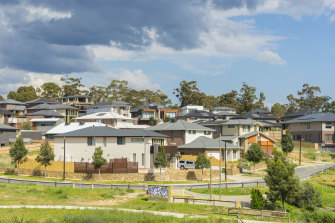Opinion
Aussie home values are about to tumble. We should let them
Jessica Irvine
Senior economics writerYou have probably heard the news that national home values are forecast to fall about 15 per cent over the coming 18 months. That’s the prediction of the economists at the nation’s biggest bank, Commonwealth Bank, anyway.
Sydney and Melbourne are tipped to bear the brunt of price falls. If you’re a home owner, you’d probably greet this news with some degree of trepidation. If you’re an aspiring first-time buyer, excitement, perhaps.
By number, of course, more Australians own their homes (either outright or with a mortgage) so news of falling prices tends to be put in the “bad news” category. But I’d like you to shift your mindset. Falling house prices (at least, of the magnitude tipped) are, in fact, good news.
Stick with me.
First, there is nothing unexpected or alarming about falling values at this point. In fact, it’s entirely to be expected and make a lot of sense. Why? Because house prices – like all prices in the economy – are influenced by both supply and demand.
And a huge story is unfolding on the demand side of the equation right now. That’s because changes in interest rates directly affect how much money people can borrow to spend on housing.
Over the past three decades, there have been several structural downward shifts in interest rates. At every opportunity, Australians have used cheaper debt to borrow more, pushing up the value of homes (supply, of course, has failed to keep pace).
So what happens when interest rates move in the opposite direction: up? We’re about to find out, but in a nutshell: demand goes down. Why? Because new borrowers can borrow less.
If you walked into a bank a year ago, you’d have been offered an interest rate of about 2 per cent and the bank would have applied a “stress test” to make sure you could afford the same loan with an interest rate of 4.5 per cent. If you had enough spare cash flow – after your non-housing living expenses were deducted from your income – to service the minimum repayments at that level, bingo, you got the loan.
Since then, the Australian Prudential Regulation Authority (APRA) has actually increased the stress test to 3 percentage points above the loan rate and the loan rates themselves, have of course, risen a whopping 0.75 percentage points since last month. Fewer borrowers will be able to afford the loan sizes they want at the new prevailing rates.
Actually, it’s worse than that. Thanks to inflation and the rising cost of living, people’s cash flow surpluses are also being crimped. That is, once you deduct higher living costs from stagnant wages, there is less cash flow available to service a loan – even if rates hadn’t gone up.
It’s a double whammy hit to borrowing power.
So, yes, the air is about to go right out of the housing market’s tyres, absent any dramatic changes in policy from the currently predicted path. If the CBA’s economists are right, we’re about to hand back most – but not all – of the home price gains seen during the pandemic.
That is particularly bad news for people who purchased in the last year or so, who may indeed see the value of their new homes fall below their purchase price. But, provided they stay put and can keep paying their loan repayments, they will likely weather the storm until prices rise again.

Property prices are on the way down.Credit:iStock
For people who borrowed before that, check your privilege. You have still enjoyed significant windfall wealth gains.
For anyone looking to crack into the market for shelter, falling prices are, of course, good news. Higher interest rates on savings may even help to get you there sooner (if banks pass them on, that is).
For policymakers, it is critical they let this adjustment play out. History shows that politicians have a very high “reaction-function” when it comes to home prices. Politicians of both political stripes have thrown first-home buyers on the home-price fire to stop it going out.
During the early days of the global financial crisis, the Rudd government – despite being elected on a platform to try to improve housing affordability – decided to double first-home owners grants and tripled them on new homes in an attempt to prop up home values.
During the pandemic, the Morrison government expanded schemes to help first-time buyers get into the market on minimal deposits – essentially bringing forward demand into the market. While both policies carry the guise of helping first-home buyers, in reality they just add to demand and inflate prices further.
It’s unclear what impact the NSW government’s proposal to axe stamp duty and introduce a broad-based land tax will have on property values. Replacing one tax with another of equivalent value should, in theory, have the same impact on people’s appetite for property. Much will depend on the exact design and timeframe for the tax switch.
As for the new federal Labor government, the best that can be hoped – after it ditched its 2019 election housing tax policies – is that they will opt for a policy of “do no harm”, and not actively pursue policies to inflate housing demand again, as their predecessors did.
Housing market adjustments hurt. But in the long run, it’s better that home values do give back some of their super-sized gains of recent years. Every Australian deserves the chance to own a home, and falling prices give younger buyers a fighting chance.
Let them have it.
Cut through the noise of federal politics with news, views and expert analysis from Jacqueline Maley. Subscribers can sign up to our weekly Inside Politics newsletter here.